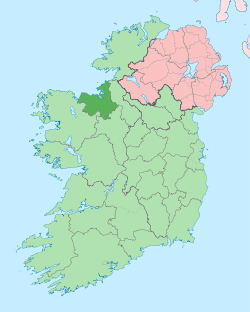Ballysadare
| Ballysadare Baile Easa Dara | |
|---|---|
| Town | |
 Ballysadare Location in Ireland | |
| Coordinates: 54°12′42″N 8°30′34″W / 54.2117°N 8.5094°WCoordinates: 54°12′42″N 8°30′34″W / 54.2117°N 8.5094°W | |
| Country | Ireland |
| Province | Connacht |
| County | County Sligo |
| Elevation | 55 m (180 ft) |
| Population (2011) | |
| • Urban | 1,344 |
| Time zone | WET (UTC+0) |
| • Summer (DST) | IST (WEST) (UTC-1) |
| Irish Grid Reference | G668293 |
Ballysadare (Irish: Baile Easa Dara, meaning "settlement of the cascades of the oak") is a village about 7 kilometres (4 miles) south of Sligo town Centre. The town developed on an important crossing of the Owenmore (Irish: Abhainn Mór, meaning "Great River"), River.
Location and naming
The Ox Mountains (Irish: Sliabh Gamh) are located west of the village. The village itself is named after the falls on the Owenmore River. Ballysadare is in the barony of Leyny, formerly the túath of Lúighne. It is in the diocese of Achonry and parish of Ballysadare.
Alternative names for the falls are Ess Mac Modairn (Falls of the son of Modairn) and Ess na n-Éan (The Falls of the Bird).
Early History
Ballysadare is a possible location for the town noted as Nagnata on Claudius Ptolemy's 2nd century CE co-ordinate map of the world.[1] Ballysadare was anciently a major gathering place for all surrounding districts.
St. Columba visited Ballysadare in 575 AD at which "Before the Saint (Columba) returned to Britain he founded one church in the district of Carbury, and proceeded from thence to a place called Easdara, where all the prelates of the neighbouring regions, and vast numbers of holy men and women had come to meet him ; and, to say nothing of the rest of the multitude, which was almost beyond counting, a great many distinguished saints of the race of Cumne are recorded to have been present." This extract is from Colgans Acta Sanctorum Hiberniae.
The O'Hara were the lords of Lúighne.
Saint Féichín
St Féichín was born in the townland of Billa in the parish of Ballysadare.[2] He is said to have studied under St. Nath Í of Achonry further to the south in the same territory. The word Bile means a sacred tree or grove. The townland is the location of the Leaba St. Féichín or St. Feichins bed. The town developed near a church founded by St. Féichín, some time before he died in 664 AD (O’Rorke 1878, 1-4).This monastic site is in Kilboglashy townland and the remains consist of a stone church known as the Great Temple of St. Féichín (Teampal mór Féichín), with a later Romanesque style carved doorway, two small buildings and a graveyard. The O'Duillenain, were erenachs of Ballysadare.
The Canons Regular of St. Augustine built a new priory a short distance to the west in Abbeytown Townland in the 13th century. Ballysadare was mentioned in the Annals of the Four Masters 15 times between 1158 and 1602, in 1188, 1199, 1228, 1230, 1235, 1239, 1249, 1261, 1267, 1285, 1360, 1444, 1595 and 1602.[3] In 1360 the Annals of the Four Masters note: A bridge of lime and stone was built by Cathal O’Conor across the river of Eas-dara. In 1588 all monastery lands around Ballysadare were seized by the Dublin government on behalf of the Crown.
The Mines
Ballysadare is the site of an ancient silver and lead mine, re-opened and worked in the 19th and 20th century. It is now the site of a quarry.
Recent History
The location of Pollexfen Mills. There is also a hydro electric power station in the vicinity.
The area experienced rapid development during the 'Celtic Tiger' boom, with many new housing developments, many of which now lie empty, creating phantom estates. The village was bypassed by the N4 Sligo-Collooney dual-carriageway, completed in January 1998. The N59 Ballina-Sligo road still winds through the village.
Education
It is home to St. Mary's College,a secondary school which serves the southern and western environs of County Sligo, including the surrounding areas of Collooney and Coolaney. There is also St. John's national school which serves the surrounding area
Transport
Ballysadare railway station is located on the Dublin-Sligo railway line and the Western Rail Corridor but is currently closed to passengers.
See also
References
Ballysadare Gallery
-

An abandoned apartment block in Ballysadare.
-

Ballysadare Bay.
-

A Ballysadare butchers.
-

Holy Trinity Parish Church, Church of Ireland.
-

A new development in the town centre.
-

Ballysadare Roman Catholic church.
-

Ballysadare river.
-

St. Mary's College - A catholic voluntary co-educational secondary school.
-

An older shop in Ballysadare.
-

A street view in Ballysadare.
-

A street view in Ballysadare.
-

A street view in Ballysadare.
External links
| Wikimedia Commons has media related to Ballysadare. |
